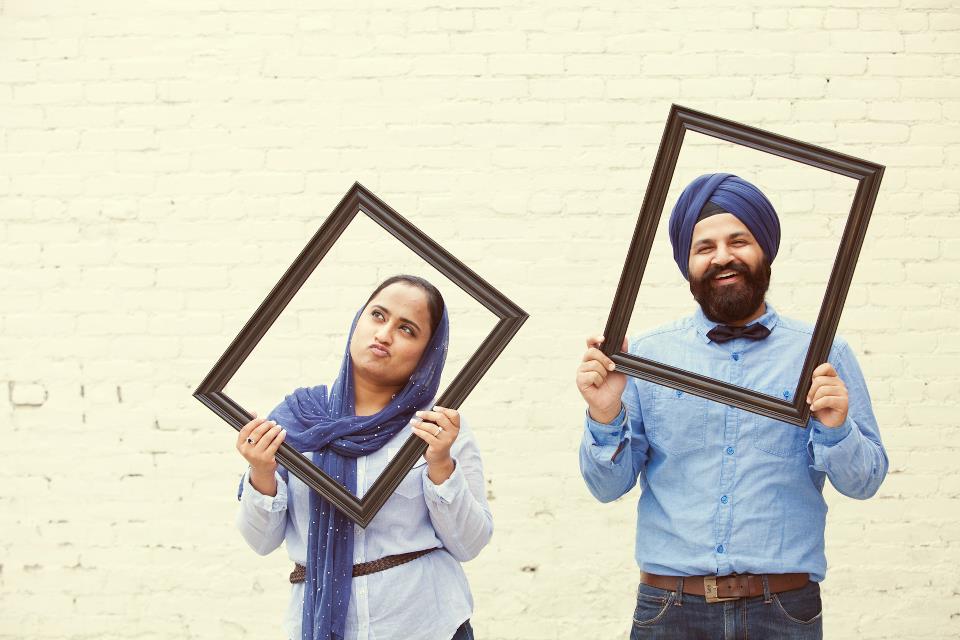With Pride Month concluding, Arunima (all pronouns) shares a moving account of how she has come to understand gender fluidity as invaluable to their Sikhi and illumination. Arunima shares guidance which, Guru Nanak Sahib and Mool Mantar gave us, to transcend the violence in our thoughts and actions by understanding that it is a product of separation. He invites you to respond to this reflection, and your inner self, with all the love & care you can hold.
by Arunima
Is gender a source of immense comfort,
or is it the cause of immense torment?
Vichaar karo (reflect): How does the gender marker you associate with yourself give you a sense of stability and belonging? At the same time, do you experience discomfort because of this identity marker; been told to stay in line because that’s “how X gender behaves”?
One of my body’s earliest memories is being seated in a 150 year-old army barrack converted into our classroom and anticipating recess with a generous dose of terror. A group of strange and rowdy boys, whom I did not know, used to chase after me every recess as soon as the bell rang. I know I neither invited nor initiated this pakdan-pakdai (none-sense). A source of terror, and by definition a traumatic experience, some would pass off as playful. When you experience trauma, the stimulus/situation which overwhelms your nervous system and leaves a lasting impact on you also creates associations that you relive in the future. Now, we see some of us are being raised to be {playfully/’normally’} violent, because power and freedom are our birthright, while some of us are spending our lives learning to protect our bodies from being violated. Violated we shall be, and be shamed and blamed for another’s violent behavior too. Thus, violence continues.
One afternoon when I was 6, my mother walked into her room to find me sitting on her bed with my thighs at quite a distance from each other {that which we have no language for other than ‘spread apart’}. “Women don’t sit like that, Arunima!”
I see.
While my mother may have reprimanded my posture sternly because she shared a limiting vision of how womxn behave, what took longer for me to understand was that her words were motivated by the desire to protect my body from at least some violence she knew I would endure because the world had declared my body ‘female’: essentially feminine. *Even the widely accepted definition of femininity is tautological, which means it is defined unto itself: someone who is feminine behaves as a woman does.
I backpacked in Himachal by myself when I was 19. Awed disbelief from cis-men and echoes of fear for my safety from cis-women I knew followed this decision. While walking through Kalga village, I came across a group of 8-10 children. A young one ran up to me and immediately enquired if I was a boy or a girl. His insistent tone unsettled me at first. My inner social scientist recovered quickly to ask him, “What do you think?” He responded more insistently, “No! You tell me, are you a boy or girl?”
His demand that I be only one or the other made sense to me yet, it really had no sense.
Around the same time as the pakdan-pakdai incident, beloved birther Jagdeep Kaur and I would go to Harmandir Sahib for darshan (occaision of seeing sacredness) at least once a week. We loved and looked forward to this time. Sometimes I would deliberately forget to bring a chunni (head scarf), and giddily run to the Gurudwara’s communal basket to claim a basanti patka (head cover). The patka has more stability while the chunni’s elusiveness gives each a distinct character and makes me enjoy adorning both equally. Not to mention that 5-year-old Arunima’s aesthetic sensibilities found both complementary with their then-haircut.
So my dear
young one,
I am both.
I am neither.
I am a being.
Living this unitary reality is our culturally and ancestrally grounded (r)evolution.
My gender fluidity is Ik Onkar in practice
My relationship is with my physicality as a body-form.
What essence do the words male or female really have?
How do they bring me closer to the Truth…?
Through Spirituality and Sikhi, I practice embodying awareness of the (non) self.
I love how Dr. Nikky Guninder Kaur-Singh deconstructs the Metaphysics of Japji Sahib: she calls it a sensuous metaphysics, i.e. that which asks us to cultivate the mind’s sensorial faculties. Dr. Kaur-Singh highlights that Guru Nanak ji emphasized knowing the Supreme Reality comes by learning to be in complete harmony with our corporeality, not by rejecting the body on the basis of any qualities. Nanak ji is clear that the Divine Truth shines through us when we strive to live with ethics and honesty. I see this for all of us who have transcended the gender or sex binary’s false dualism.
We can understand the gender/sex binary as a mayaic manifestation of dvait, duality, or dooja bhav. If you don’t yet know, cell biologists have recently verified that humans’ sex characteristics are not simply either ‘male’ or ‘female’. “The idea of two sexes is overly simplistic” because in fact each human being’s corporeality is uniquely varied. Our body has an ever-changing composition, alongside a long-lasting interplay between evolving genetic, cellular, and genital characteristics.
Kindly take care to understand my words: are gendered characteristics, which we take to be inherent, really fixed and unchangeable? While we continue to reinforce that (bodies we’ve marked as) women are inherently weak, can that be a universally true reality? Or is it that all attributes, such as strength, vulnerability, and awareness, are the outcome of thoughts and actions we cultivate? This makes reality a reinforcement of patterns of thoughts, actions, and beliefs. By meditating on our true Nature, we shall know this. So when we aim to practice virtue and ethics in our day-to-day, we already are transcending limitations otherwise taken to be essential or unchangeable.
The more we treat gender as a cage, the more we concretize an illusion.
This cage served ultimately to separate myself from Being and my being from Loving.
In Ik Onkar, I see the Source. Love.
“You come from the One, you are One,
and you are without any limits or restrictions Loved by the One.”
So, what do we do with gender?
You can transcend gender no matter which markers you feel comfortable with. All ten Gurus were fearless advocates for human beings to expand our minds. Yet, we see that societies are still forcing Trans*, Nonbinary, and Queer Sikhs to live with fear. Our own communities in South Asia and the global diaspora are inconsiderate, violent and unaccepting. We laugh, casually insult, and disrespect the humanity of trans people. We are driving Queer Sikhs to suicide while melanated Trans angels are being killed from hate crimes at alarming rates. We know the pain of violence ourselves, especially religious persecution, then why do we choose to be violent when we can lovingly accept human beings who are striving to exist in alignment with Ik Onkar?
I’m confident that as loving beings, it’s time to start putting into practice our beliefs that all people deserve freedom. prabhdeep kehal writes in their reflections on being GenderQueer and Sikh, “I take seriously that “sikh”, when read as a verb, means “learn.” Learning and spreading bone-deep acceptance starts in our own mind. The honest practice of your love has the power to transform the violence you carry. When we make a habit of reflecting on how our subconsciously programmed behaviors are creating violence for ourselves and others, then we are living as Guru ke pyaareon (Guru’s beloved).
ਥਾਲ ਵਿਚਿ ਤਿੰਨਿ ਵਸਤੂ ਪਈਓ ਸਤੁ ਸੰਤੋਖੁ ਵੀਚਾਰੋ ॥
thaal vich ti(n)n vasatoo pieeo sat sa(n)tokh veechaaro ||
Upon this platter, three delicacies have been placed: Truth, Contentment and Contemplation.
ਅੰਮ੍ਰਿਤ ਨਾਮੁ ਠਾਕੁਰ ਕਾ ਪਇਓ ਜਿਸ ਕਾ ਸਭਸੁ ਅਧਾਰੋ ॥
a(n)mirat naam Thaakur kaa pio jis kaa sabhas adhaaro ||
The Master has also placed upon it the Ambrosial Nectar of Naam; it is the support of all.
ਜੇ ਕੋ ਖਾਵੈ ਜੇ ਕੋ ਭੁੰਚੈ ਤਿਸ ਕਾ ਹੋਇ ਉਧਾਰੋ ॥
je ko khaavai je ko bhu(n)chai tis kaa hoi udhaaro ||
One who eats it and savors it shall obtain liberation.
I invite you to contemplate your experiences with gender, and invest the energy you reap into a more loving relationship with yourself. If you find comfort in the gender/sex identity marker that was assigned to you at birth, use this privilege to create a welcoming space for thos of us who trans*cend this binary, boundary, border. Open up your heartmind to Ik Onkar. Bring this (r)evolution to your families, friends, and communities. Honor the divine wholeness of our Nonbinary bodies.
ਇਉ ਕਹੈ ਨਾਨਕੁ ਮਨ ਤੂੰ ਜੋਤਿ ਸਰੂਪੁ ਹੈ ਅਪਣਾ ਮੂਲੁ ਪਛਾਣੁ ॥੫॥:
eiau kahai naanak man too(n) jot saroop hai apanaa mool pachhaan ||5||
Thus says Nanak – O mind! You are “Jot Saroop” – you are Pure Light, pure Consciousness, Pure Nature! Recognize your Mool, your Source, Origin, Reality, Divine Nature. ||5|| Sri Guru Granth Sahib, 441
All in, and of, this universe is kudrat (nature).
ੴ
ਸਤਿ ਨਾਮੁ
ਕਰਤਾ ਪੁਰਖੁ
ਨਿਰਭਉ ਨਿਰਵੈਰੁ
Ik Onkar, Satnaam. Karta Purakh. Nirbhau. Nirvair.
Authors’ Note
The question: what is gender? is a universe of its own. There are so many understandings of this phenomena and its natural-socio-cultural roots. Studies have established that seeing gender as binary (male or female) is a social construction. At the same time, everyone I’ve talked to about their gender feels that we do not and can not totally control the variant of gender we find most comfort in. My understanding, for now, is that gender (including the lack of any) can be understood as a form of natural expression deeply connected with our sense-of-self and life experiences.
The sphere of gender I emphasize in this reflection is its use to imbue us with limiting behaviors that diminish our spiritual self growth. Reflect on the limitations you have come to believe about yourself, and how they may tie to the behaviors expected from gendered bodies, such as: “if you express vulnerability or human emotions, you are emasculating yourself.” Or “As female/feminine you perpetually care for others, and being publicly confrontational makes you unsightly and aggressive” and so on.
Gender-as-expression is also not without its paradoxes. Epistemologically, the function of a definition is to set a boundary. At the same time, there is no limit on how much consciousness increases our understanding, so how you express gender changes and evolves as you learn, too. If we are asked, what is feminine? I don’t know which quality we could convincingly state as all who identify with the feminine having in common. In my mind, feminine and masculine energies are not mutually exclusive. We have the capacity to be strong and soft at the same time. Ik Onkar.

The Author: Arunima is the ‘first ray of sunshine’ or ‘red glow of dawn’ in Sanskrit. Arunima is on a mission to transform this planetary climate of pain into healing by bringing to light the union of our timeless nature and cultures. Arunima uses all/any pronouns, loves trail running, protein shakes, and all the forests of the world! With a deep investment in nourishment and interests as wide-ranging as this cosmos, A invites you to share how you de-stress and anything else on your mind at their instagram.com/thegurhlife.





1 Comment
Anonymous
09/27/2021 at 11:56 amVery thought provoking
Yes i believe one step on spirituality os not identifying with our body and that includes the social norms associated with the body.
However, I do think we have a responsibility to perform the duties of gender.
While yes the Gurus fought all social norms that were senseless and kept women oppressed, they advocated for family life and encouraged people to fulfill the gender roles and duties needed.
Yes we need to transcend temporary things like gender, religion, and ego to merge with oneness.
But I am afriad, that might co-opted by organizations and people who plunge is more into this temporality. By having people endlessly agonize over which is the right gender for me.
That little boy was not wrong in demanding an answer. That is his worldview and those categories of male female are useful and help navigate reality.